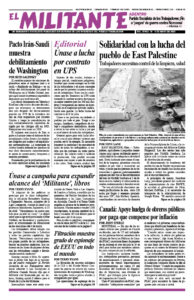As food prices keep rising, many companies are seeking to maximize profits through “shrinkflation,” which some workers call “skimpflation,” where they fiddle with the packaging and you end up paying the same price but get less.
Bosses have been doing this for years — yogurt cups have shrunk from 8 ounces to 5.3 — but with growing inflation the practice has spread more widely.
General Mills has shrunk its “family size” cereal boxes from 19.3 ounces to 18.1. Gatorade replaced its 32-ounce bottle with a 28 ounce one — 14% less. A company spokesperson tried to paint this as a big help to the consumer, saying it made the bottle “easier to grab.”
Walmart Great Value paper towels dropped from 168 sheets per roll to 120. Hershey cut down its 18-ounce pack of dark chocolate Kisses by almost two ounces.
Frito-Lay shrank bags of Doritos from 9.75 ounces to 9.25 by taking out five chips. “We took just a little bit out of the bag so we could give you the same price,” a Frito-Lay spokesperson said, “and you can keep enjoying your chips.” The list goes on.
Within the span of a few months last fall, a number of these companies, including General Mills, Hostess Brands and PepsiCo Inc.’s Frito-Lay, began selling shrunken “miniature” versions of their wares, including Trix, Twinkies, Ding Dongs and, yes, Doritos.
In Lyons, Kansas, Jenni Dickson was excited when the mini-Doritos appeared at her local grocery store earlier this year, as her 6-year-old loves them. “They’re cute,” she told the Wall Street Journal, “but it’s like eating a can of crumbs.”
Some of these new products have become so small they now fit into places other than a little child’s mouth. In Grandview, Texas, Stephanie Beasley told the Journal her 2-year-old daughter recently stuck a mini-Trix up her nose and it had to be removed with a small crochet hook.
Hostess’ Twinkies, Ding Dongs and Donettes have now been cut to golf-ball-size “Bouncers,” the bosses said, to help you eat one in just two bites.
All these hustles are products of the bosses’ drive for profit amid the sharpening competition resulting from today’s worldwide capitalist crisis of declining production, trade and jobs. This has been exacerbated by the effects of Moscow’s invasion of Ukraine over a year ago.
In an effort to slow the climb of inflation, the Federal Reserve has been stoking up interest rates. They made a big fuss over a decline in the consumer price index to 5% in March, most of which was the result of a fall in gasoline prices. Government officials claim this shows that inflation is now coming under control. But working people see something different in the real world.
Prices have continued to spiral up for key necessities, like food, other groceries and rents.
Food prices rose 8.5% from a year ago, with eggs up 36%, frozen vegetables up 20.1%, flour up 17.5% and cookies — whatever the size of the package — 16.6%.
Rents have risen 8.2% and electricity bills have jumped 10.2%, forcing even more workers — especially the young — to move in with family and friends. This means it takes longer and longer to be able to start a family.
And the increasing interest rates, going up at the steepest pace since the 1980s, mean what workers owe on their credit cards, mortgages, car loans and other debts is going up.
U.S. workers haven’t seen a rise in real wages since the 1970s, while inflation is eating away at what we can afford to buy. In the bosses’ drive to keep profits as high as possible, they’re stepping up attacks on workers’ wages, lengthening the workday and week with no increase in pay, pushing punishing speedup, ignoring worsening working conditions and looking to lay off workers and pile their work on the backs of those who remain.
The result is workers increasingly turning to their unions, looking for a way to fight back.

